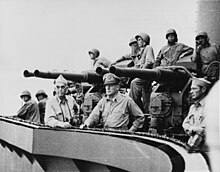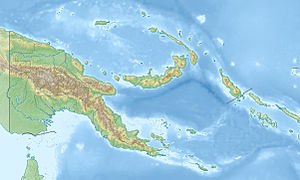Admiralty Islands
| Admiralty Islands | ||
|---|---|---|
| Area map of Manus | ||
| Waters | Bismarcksee | |
| archipelago | Bismarck Archipelago | |
| Geographical location | 2 ° 6 ′ S , 146 ° 56 ′ E | |
|
|
||
| Number of islands | 40 | |
| Main island | Manus | |
| Total land area | 2170 km² | |
| Residents | 58,000 (2011) | |
| Situation map of the province | ||
The Admiralty Islands ( English Admiralty Islands or Manus Islands ) belong to the Bismarck Archipelago and form a group of islands in the Pacific Ocean northeast of New Guinea . Together with the smaller Western Islands, the islands form the Manus Province in the island region of Papua New Guinea .
geography
The actual Admiralty Islands consist of the main island of Manus (also called Taui on old maps ), a very mountainous island that has not been explored for a long time, as well as a number of small coral islands .
The archipelago comprises around 40 islands, 18 of which are larger, and covers an area of 2,170 km². The larger islands or archipelagos are:
- Alim Islands , formerly "Elisabeth Islands"
- Lou , formerly "St. George's Island"
- Los Negros Island
- Manus - the main island, 1,554 km²
- Ndrova Island
- Nihon Island
- Tong
- Pak , formerly Saint Gabriel Island
- Rambutyo , formerly Jesus-Maria-Insel
- St. Andrew Isles
- Johnston Islands
Usually the Purdy Islands and Baluan are also included in the area.
The islands are mainly covered by tropical rainforest and are home to a large number of rare plants, birds (including large foot fowl ) and mammals (including bats ).
The capital of the province of Manus is Lorengau on the main island. The highest point is Mount Dremsel (German: Dremselberg ) at 720 meters.
Population and languages
As in New Guinea, there is an enormous diversity of languages and peoples on the islands. The indigenous inhabitants are ethnically counted among the Melanesians . The group of Admiralty Island languages alone is made up of 31 individual languages that belong to the oceanic group of the East-Malay-Polynesian branch of the Central-East group of the Austronesian language family .
The islanders have traditionally specialized in subsistence-oriented fishing; other food was previously exchanged for fish among the neighboring peoples.
58,000 people live on the islands today (2011).
Cultures
The indigenous people of the Admiralty Islands have retained some elements of their traditional cultures. So the majority of people still pursue traditional economic forms in an unchanged manner. According to UNESCO, only three of the 31 languages are endangered.
The division of labor between the sexes is still pronounced, although not as strong as it used to be. The men of the coastal residents, for example, are responsible for building buildings and canoes, fishing in the open sea, harvesting palm fruits and preparing the gardens. The women do all other agricultural work, fish together with the men near the coast and are responsible for looking after the house, clothing and the village paths. The social structure is predominantly patriarchal , although women play an important role in the ritual culture.
After the Second World War it came through the work of Christian missionaries and the influence of Australia's cultural upheaval: The ethnic religions in the archipelago - belief in spirits and a pronounced ancestor worship - are now largely disappeared after the current surveys of evangelical fundamentalist oriented conversion network Joshua Project are almost 95% of the people - at least officially - Christians In the past, for example, there were strict totemic marriage rules that only allowed marriages between different totem clans. Such ethical norms were largely abandoned in the course of Christianization; only various rituals remind of it.
While traditional clothing (men's raffia bandages, women's fiber aprons or raffia aprons) has largely been replaced by modern items of clothing, classic jewelry (shell discs, chopstick combs, nose sticks, neck hangers made of bones, objects made of feathers or bark) are still worn, at least for festivities.
The gabled huts made of woven palm straw and simple outrigger boats with square mast sails have been replaced in part by corrugated iron walls or modern boats.
(see also: Cultures on Manus )
history

Together with New Guinea , the Bismarck Archipelago and the Solomon Islands , the Admiralty Islands were first settled around 40,000 years ago in a wave of migration from Southeast Asia , in which Australia was also populated. The early immigrants cultivated taro and introduced wild plants and animals from New Guinea, such as: B. nasal sac . Obsidian was collected and traded.
The Lapita culture originated 3,500 years ago and reached from the Admiralty Islands to Tonga and Samoa . Its origins are controversial, but could have been the result of a renewed wave of migrants from Southeast Asia. The Lapita culture included the introduction of ceramics , stilt houses and domestic animals ( pigs , dogs and chickens ) as well as major developments in agriculture and boat building that allowed large-scale trade. The Lapita Society disappeared 2,000 years ago.
The first European to reach the islands was Álvaro de Saavedra in the summer of 1528. Saavedra named the islands Urays la Grande .
The archipelago was rediscovered by Schouten and Le Maire in 1616, before Philipp Carteret found them again in 1767 and gave them their current name. In 1781 she was sighted by Maurelle and named as Don José Basco . In 1792 Joseph Bruny d'Entrecasteaux landed on the islands. After that, it was not until 1874 that the crew of the British war schooner HMS Alacrity carried out a number of surveys on the island group. In March 1875, investigations of the HMS Challenger followed , during the expedition of the same name under the scientific direction of Charles Wyville Thomson .
The Admiralty Islands were placed under the protection of the German Empire by an imperial letter of protection of May 17, 1885, along with the other possessions of the German New Guinea Company in the Bismarck Archipelago and New Guinea. After 1900, the company Hernsheim & Co operated small coconut plantations and two commercial branches on the Admiralty Islands. In 1911, the colonial administration of German New Guinea set up a government station on the main island of Manus. It was in the place Seeadlerhafen in the east of the island. In 1908 the archipelago was re-examined by the German survey ship Planet . In 1908 the Hamburg South Sea Expedition was active here.
During the First World War , the islands were conquered by Australia in 1914 , which later also received the administrative mandate for the entire Bismarck Archipelago from the League of Nations (now the United Nations ).
During the Second World War , the archipelago was occupied by the Japanese who set up a military base here in April 1942. On February 29, 1944, Operation Brewer began, an action lasting several weeks, which led to the conquest of the archipelago by Allied troops from the USA and Australia under the command of Douglas MacArthur . Soon a base was built that became important for further action in New Guinea and the Philippines .
After the war, the archipelago was again administered by Australia until Papua New Guinea achieved full sovereignty on September 16, 1975.
Today the Admiralty Islands belong to the Manus Province of Papua New Guinea.
Individual evidence
- ↑ Languages and Peoples of the Earth - Linguistic-Ethnographic Lexicon . Langwhich.com, search term: Admiralty Island Languages , accessed July 29, 2015.
- ↑ Göran Burenhult (ed.): Illustrated history of mankind. Volume: Primitive people today. Bechtermünz, Augsburg 2000, ISBN 3-8289-0745-8 (Original: Traditional Peoples Today , Harpercollins 1994). P. 102.
- ↑ a b c d e Roland u. Miriam Garve: Among Papuans and Melanesians. Verlag Neue Literatur, Jena - Quedlinburg - Plauen 2010, ISBN 978-3-940085-37-5 . Pp. 188-190.
- ↑ Atlas map of the Admiralty Islands on UNESCO Atlas of the World's Languages in Danger English, accessed on July 31, 2015.
- ↑ James G. Carrier: Manus - Economy. In: Countries and Their Cultures at everyculture.com, accessed July 29, 2015.
- ^ Papua New Guinea - Languages. In: britannica.com. Retrieved January 12, 2019 .
- ^ A b Matthew Spriggs : Donald Denoon (Ed.): Recent History (The Holocene) (= The Cambridge History of the Pacific Islanders). Cambridge University Press, Cambridge 1997, pp. 52-69.
- ^ Brand, Donald D. The Pacific Basin: A History of its Geographical Explorations The American Geographical Society, New York 1967, p. 121
- ^ Coello, Francisco "Conflicto hispano-alemán" Boletín de Sociedad Geográfica de Madrid , t.XIX. 2nd semestre 1885, Madrid, pp. 234, 309, 310
- ↑ a b c d Admiralty Islands . In: Heinrich Schnee (Ed.): German Colonial Lexicon . Volume 1: A - G. Quelle & Meyer, Leipzig 1920, p. 12 ff.
Web links
- across the Manus Island
- over the rainforest of the Admiralty Islands
- about the history of the Admiralty Islands




